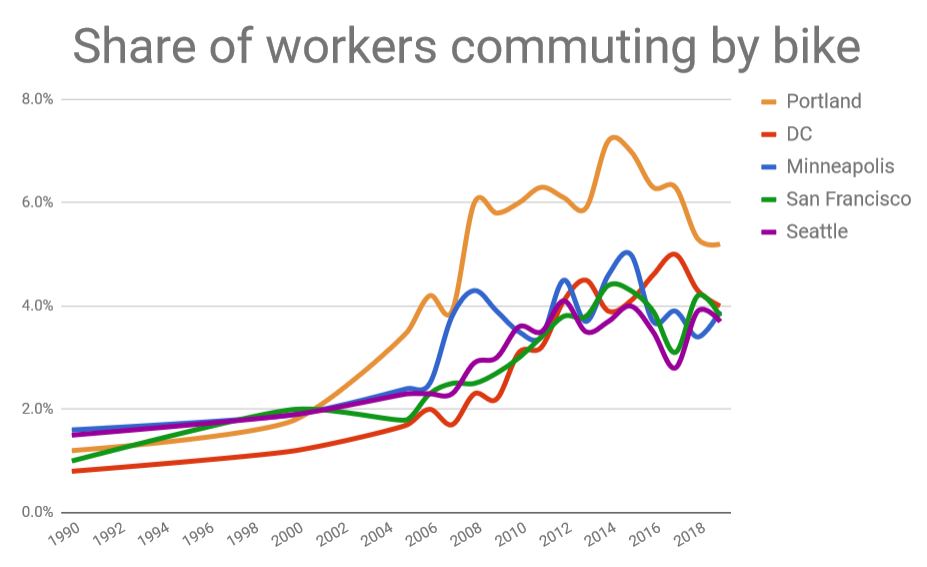This is a guest post from former BikePortland news editor Michael Andersen. He now writes about housing and transportation for Sightline Insitute, a regional sustainability think tank.
In its final snapshot of pre-pandemic travel habits, U.S. Census surveys found that 2019 was another year with little growth in bike commuting, in Portland or elsewhere.
Nobody knows, of course, exactly how the COVID pandemic will change all this. It’s just certain that it has.
Portland’s bike commuting rate was 5.2 percent, the Census found in its annual compilation of surveys collected throughout the previous calendar year, down from an average of 6.3 percent over the previous five years and the lowest single-year estimate since 2007. The new finding served as a likely confirmation of last year’s discouraging indication that Portland’s mid-decade boomlet of bike commuting seemed to have receded.
The ratio refers to the percentage of Portland residents who headed to jobs primarily by bike over the previous week.
Across the Portland metro area, the estimated bike-commuting rate was 1.9 percent, down from an average of 2.3 percent over the previous five years. The national estimate, too, was flat to down: 0.5 percent from 0.6 percent.
Other large U.S. cities with significant bike commuting were also flat or on the low end of their five-year averages.
Some Oregonians might be particularly interested in one spot of bright news: After several years of lagging seriously, Eugene’s bike commuting estimate ticked back up to 6 percent. Oregon’s third-largest city can once again claim to have more bike commuting than its largest.
Unfortunately, even that rise is well within Eugene’s larger error margin.
It’s still a complete mystery how the pandemic might change commutes

(Photo: J. Maus/BikePortland)
These 2019 estimates aren’t a big surprise.
Portland gas prices spent most of 2019 above $3 a gallon, but never flirted with $4 as they had after the recession. Despite regular incremental improvements, momentous decisions in 2018 like the Central City in Motion plan and a few major projects in the pipeline, little new infrastructure has actually hit the ground on Portland’s key commuting routes in years. In fact, one significant bike commuting pinchpoint, the Burnside Bridge, spent almost all of 2018 and 2019 pretty bad to bike on before getting an upgrade as 2020 began.
Advertisement
And speaking of 2020…
Nobody knows, of course, exactly how the COVID pandemic will change all this. It’s just certain that it has.
Even in 2019, Portland’s work-from-home rate hit an estimated 9.1 percent, another all-time high and one of the nation’s highest rates for a major city. (In case you were wondering, the exact question is: “How did this person usually get to work LAST WEEK? Mark (X) ONE box for the method of transportation used for most of the distance.”)
That work-from-home figure will surely soar in 2020 and 2021, perhaps especially for one of Portland’s core biking populations: people who work downtown. Meanwhile, the collapse in transit ridership and the boom in bike sales are introducing many more people to bikes as both recreation and transportation. And for many victims of this chaotic economy, bikes are of course a way to save money.
It’s my own belief that infrastructure investments alone don’t lead to much change in commuting habits until some sort of external force gives many people a reason to reconsider their daily routines at once. This scrambling of transportation trends can come from a gas price shift, a global pandemic, maybe even whatever other catastrophes might await us next.
— Michael Andersen: @andersem on Twitter.
— Get our headlines delivered to your inbox.
— Support this independent community media outlet with a one-time contribution or monthly subscription.


